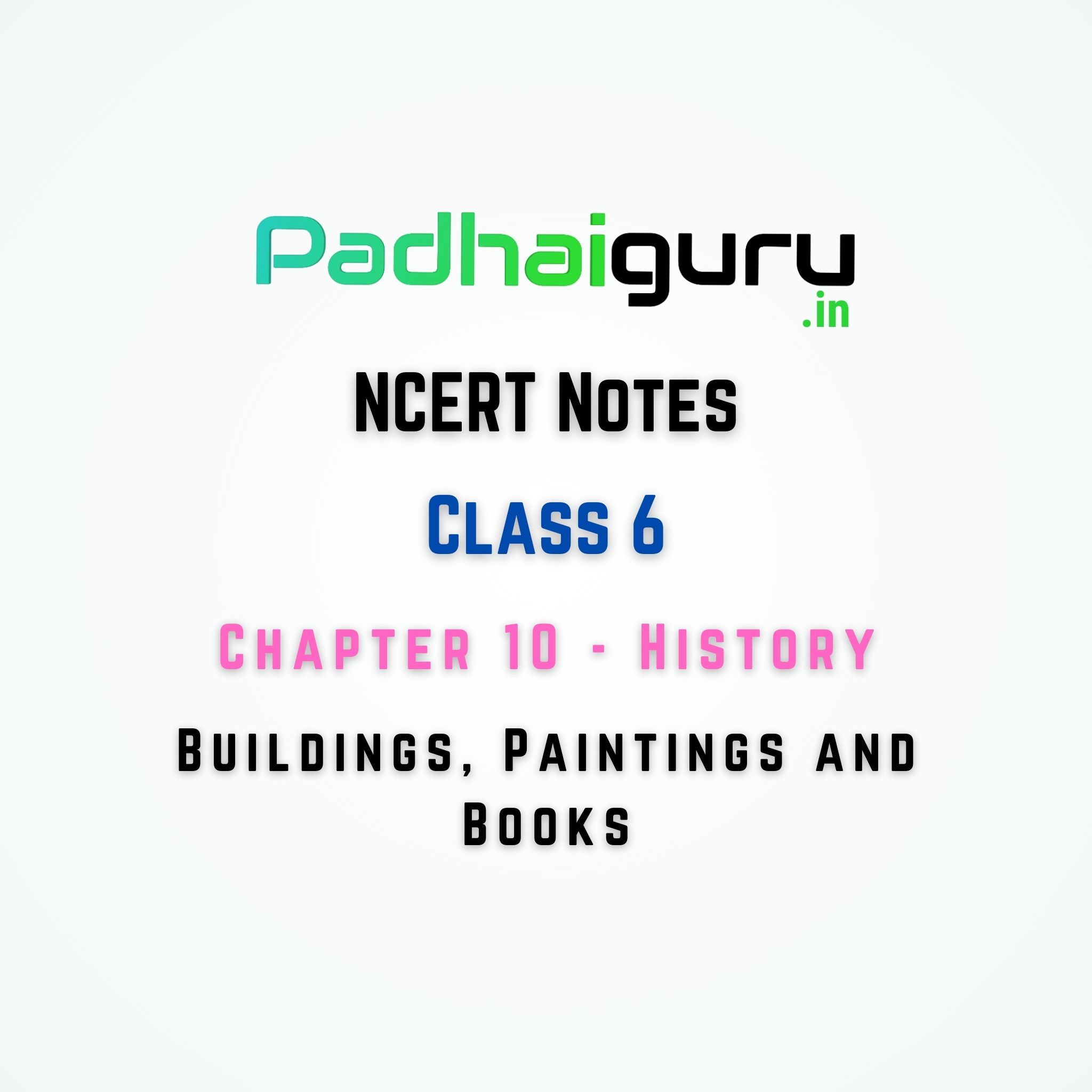NCERT Class 6 History Notes
10. Buildings Paintings and Books Class 6 NCERT Notes chapter 10 History

Welcome to NCERT Notes on class 6 Chapter 9 History From Buildings Paintings and Books .
Metallurgy in Ancient India
- Contributions of Ancient Metallurgists:
- The Harappans demonstrated exceptional skill in copper metallurgy by crafting intricate artifacts.
- They achieved the remarkable feat of producing bronze through the alloying of copper with tin.
- Transition to the Iron Age:
- The Harappan civilization belonged to the Bronze Age, succeeded by the Iron Age.
- India’s metallurgists excelled in producing advanced iron, including forged iron, wrought iron, and cast iron.
The Iron Pillar’s Enduring Legacy
- Marvel of Indian Craftsmanship:
- Standing tall in Mehrauli, Delhi, the Iron Pillar is a testament to Indian artisans’ skill.
- It was constructed from iron, measures 7.2 meters in height, and weighs over 3 tonnes.
- The pillar’s creation dates back around 1500 years.
- An inscription on the pillar links it to Chandra, a ruler of the Gupta dynasty.
- Remarkably, the pillar has resisted rusting despite the passage of centuries.
Architectural Marvels in Brick and Stone
- Skillful Craftsmanship Evident:
- Surviving structures such as stupas and temples showcase the expertise of Indian artisans.
- Distinct Features of Stupas:
- Stupas, characterized by their unique mounds, house central relic boxes.
- The railings and gateways surrounding stupas are adorned with intricate sculptures.
- Temple Architecture and Deities:
- Temples dedicated to deities showcase distinct architectural designs.
Literary Richness: Epics and More
- Unveiling Epic Narratives:
- Epics, grand compositions, narrate tales of heroism, gods, and goddesses.
- Tamil Epics:
- “Silappadikaram” by Ilango portrays themes of love and sacrifice.
- “Manimekalai” carries forward the saga of the daughter’s journey.
- Sanskrit Epics:
- “Mahabharata” recounts the epic Kurukshetra war and its ramifications.
- “Ramayana” chronicles the captivating journey of Rama.
Recording and Safeguarding Tales
- Ancient Texts and Religious Narratives:
- Puranas encompass captivating stories of gods, goddesses, and world creation.
- Legacy of “Mahabharata” and “Ramayana”:
- “Mahabharata” and “Ramayana” stand as monumental Sanskrit narratives.
- Emergence of Scientific Thought:
- Aryabhata‘s mathematical treatises and Varahamihira‘s astronomical contributions enhanced knowledge.
Ayurveda and Scientific Endeavors
- Exploring Ancient Health Sciences:
- Ayurveda, an all-encompassing health system, flourished during this era.
- Pioneers in Mathematics and Science:
- Aryabhata’s pioneering work in mathematics and astronomy revolutionized understanding.
- Ordinary Contributions to Literature:
- Ordinary individuals enriched the literary landscape through the transmission of folk stories, poems, songs, and theatrical performances.
Frequently Asked Questions (FAQs)
1. What remarkable contributions did ancient Indian metallurgists make?
- The Harappans excelled in copper metallurgy and produced bronze through copper-tin alloying.
- India’s transition to the Iron Age led to advancements in iron forging, wrought iron, and cast iron.
2. Could you share more about the Iron Pillar in Delhi?
- The Iron Pillar in Delhi, erected 1500 years ago, stands as a remarkable testament to craftsmanship.
- An inscription on the pillar links it to Gupta ruler Chandra, and its rust-free state remains an intriguing feat.
3. How were stupas and temples constructed during this period?
- Stupas, housing relic boxes, were surrounded by adorned railings and gateways.
- Temples featured distinct designs, with the garbhagriha housing the main deity’s image.
4. Tell us about the significance of Tamil and Sanskrit epics.
- Tamil epics like “Silappadikaram” and “Manimekalai” portray themes of love, sacrifice, and lineage.
- Sanskrit epics such as “Mahabharata” and “Ramayana” narrate tales of war, devotion, and heroism.
5. How did ancient India contribute to scientific and mathematical thought?
- Mathematicians like Aryabhata introduced advanced concepts, including understanding of day and night, eclipses, and circle circumference.
- Ayurveda and mathematical treatises paved the way for scientific exploration.
6. Could you elaborate on the role of ordinary individuals in preserving stories?
- Ordinary people enriched literature through folk stories, poems, songs, and theatrical performances.
- Collections like Jatakas and Panchatantra preserve these narratives.
7. What significant contributions emerged from ancient Indian health sciences?
- Ayurveda stood as a comprehensive health science, offering holistic approaches to well-being.
8. Who were some notable mathematicians and astronomers of this era?
- Pioneers like Aryabhata, Varahamihira, and others revolutionized mathematical and astronomical understanding.
9. How did epics like “Mahabharata” and “Ramayana” impact Indian culture?
- Epics played a pivotal role in shaping cultural and moral values, while offering insights into heroic deeds and divine interactions.
10. What is the legacy of this era’s literature on present-day India?
- The literature of this era laid the foundation for diverse storytelling traditions, influencing cultural identity and creativity in modern India.
This was the end of NCERT Notes on class 6 Chapter 10 History Buildings Paintings and Books.
For more information, refer to NCERT SOLUTIONS, NCERT NOTES, and NCERT BOOKS
